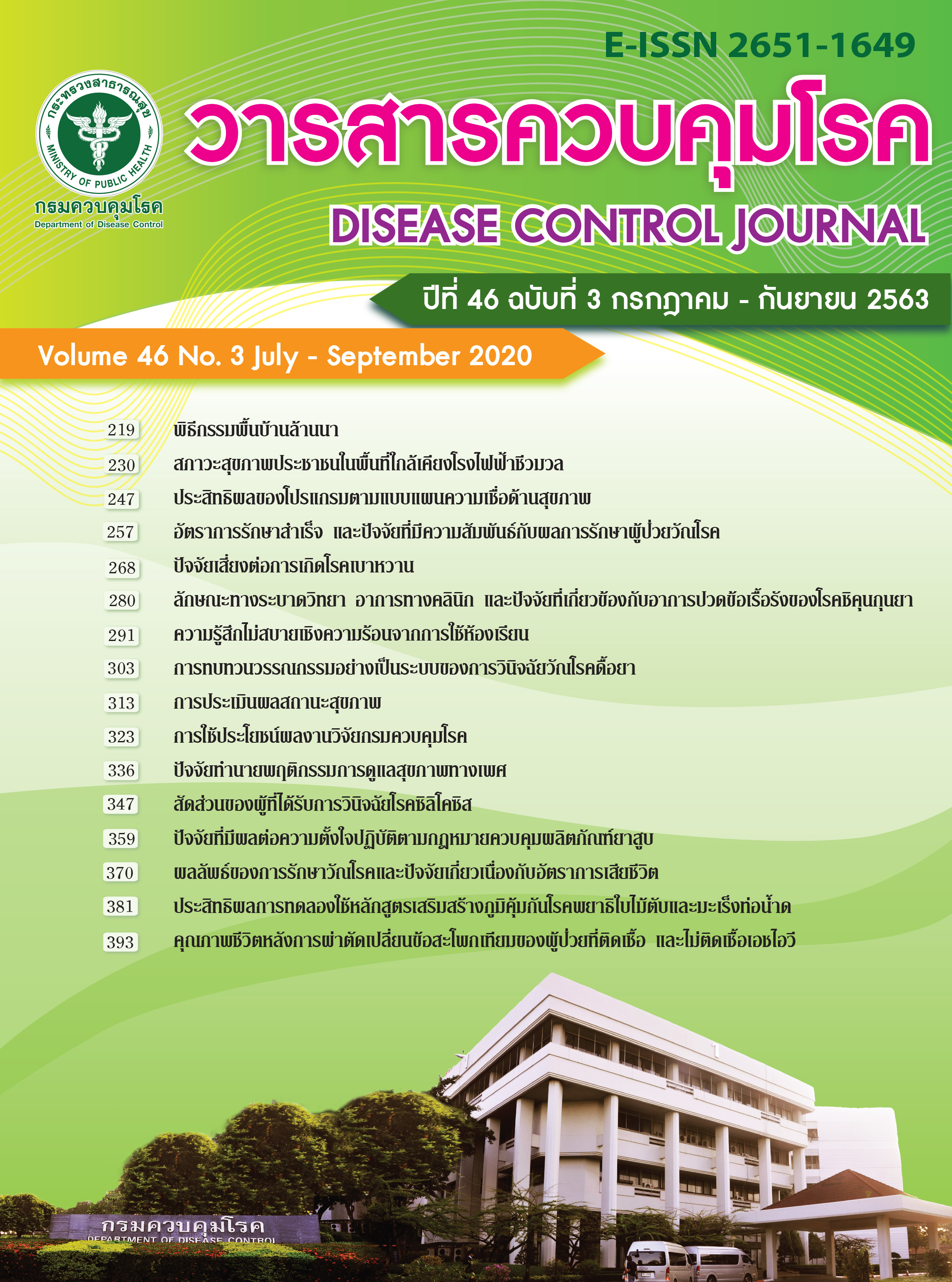The study on epidemiological characteristics, clinical signs and symptoms, and factors related to chronic joint pain of Chikungunya patients in urban area, Songkhla Province, Thailand, 2019
DOI:
https://doi.org/10.14456/dcj.2020.27Keywords:
Epidemiology characters of Chikungunya, signs and symptoms of Chikungunya, factors related to chronic joint pain doe to ChikungunyaAbstract
The outbreak of Chikungunya occurred in urban area of Hatyai District, Songkhla Province, from June 2018 to March 2019. The outbreak investigation team from the Office of Disease Prevention and Control Region 12, Songkhla, was dispatched to perform outbreak investigation. This study, which was part of this outbreak investigation, aimed to describe the epidemiological characteristics, clinical signs and symptoms, as well as factors associated with chronic joint pain due to Chikungunya. Using the case definition of the Bureau of Epidemiology, a total of 304 probable cases of Chikungunya were identified and recruited for interview about the signs and symptoms and their duration. Descriptive statistics, which include frequency, percentage, means and median, and inferential statistics, i.e. stepwise multiple regression analysis, were used. The results revealed, among probable cases, a female-to-male ratio of 1.2:1 (p-value=0.06). Most of them were in the working age groups with a mean age of 33.7 years. Seventy-one point one (71.1) percent of probable cases were living with other probable case(s) in the same household. Major signs and symptoms were fever, joint pain and rash. The fever, which was most commonly found in the first three days of illness onset, was sometimes accompanied by headache, peri-orbital pain, conjunctivitis, and nausea. After fever, joint pain occurred and followed by rash lasting for about one week. The cases with pain in multiple joints accounted for 94.4% and those with pain rotating to a different joint at any given time 21.1% of all cases. Most of joint pain events were in the knees (83.6%), ankles (80.6%) and fingers (74%). In addition, it was also found that female and elderly populations were more likely to suffer from chronic joint pain. Findings from this study suggested that detection of clusters of patients with fever, multiple joint pain and rash and more than one case in the same household should be suggestive of chikungunya outbreak, and the incidence should be promptly notified to local public health officials so that disease control measures can be implemented in a timely manner. Female and elderly populations are particularly recommended to prevent mosquito bite, which is the cause of Chikgununya infection, as they are more likely to develop chronic joint pain if infected.
Downloads
References
Lee VJ, Chow A, Zheng X, Carrasco LR, Cook AR, Lye DC, et al. Simple clinical and laboratory predictors of Chikungunya versus dengue infections in adults. PLoS Negl Trop Dis 2012;6:e1786.
Hammon WM, Sather GE. Virological findings in the 1960 hemorrhagic fever epidemic (dengue) in Thailand. Am J Trop Med Hyg 1964;13:629-41.
Rachatathat A, Oppapong T. The situation of Chikungunya. in: Rachatathat A, Oppapong T, Suwanpanyalert N, Srisawat T, editers. Chikungunya fever. 2nd ed. Nonthaburi: Department of Disease Control; 2552. p. 5-12. (in Thai)
Bureau of Epidemiology. Definition of Infectious disease [Internet]. [cited 2019 Apr 18]. Available from: http://www.boe.moph.go.th/fact/Chikungunya.htm
Ponlawat A, Harrington LC. Blood feeding patterns of Aedes aegypti and Aedes albopictus in Thailand. J Med Entomol 2005;42:844-9.
Nakkhara P, Thammapalo S, Loimek S. Risk factors for Chikungunya virus infection in the re-emerged outbreak villages, Takbai district, Narathiwat province during 2014-2015. Journal of the office of DPC7 Khon Kaen 2019;26:48-58. (in Thai)
Weaver SC, Lecuit M. Chikungunya virus and the global spread of a mosquito-borne disease. N Engl J Med 2015;372:1231-9.
Furuya-Kanamori L, Liang S, Milinovich G, Magalhaes RJS, Clements AC, Hu W, et al. Co-distribution and co-infection of chikungunya and dengue viruses. BMC Infect Dis 2016;16:84.
Essackjee K, Goorah S, Ramchurn SK, Cheeneebash J, Walker-Bone K. Prevalence of and risk factors for chronic arthralgia and rheumatoid-like polyarthritis more than 2 years after infection with chikungunya virus. Postgrad Med J 2013;89:440-7.
Rodríguez-Morales AJ, Cardona-Ospina JA, Fernanda Urbano-Garzón S, Sebastian Hurtado-Zapata J. Prevalence of post-chikungunya infection chronic inflammatory arthritis: a systematic review and meta-analysis. Arthritis Care Res 2016;68:1849-58.
Heath CJ, Lowther J, Noël TP, Mark-George I, Boothroyd DB, Mitchell G, et al, editors. The identification of risk factors for chronic chikungunya arthralgia in Grenada, West Indies: a cross-sectional cohort study. Open Forum Infect Dis 2018;5:1-10.
Moro M, Grilli E, Corvetta A, Silvi G, Angelini R, Mascella F, et al. Long-term chikungunya infection clinical manifestations after an outbreak in Italy: a prognostic cohort study. J Infect 2012;65:165-72.
Sissoko D, Moendandze A, Malvy D, Giry C, Ezzedine K, Solet JL, et al. Seroprevalence and risk factors of chikungunya virus infection in Mayotte, Indian Ocean, 2005-2006: a population-based survey. PLoS One. 2008;3:e3066.
Downloads
Published
How to Cite
Issue
Section
License
Articles published in the Disease Control Journal are considered as academic work, research or analysis of the personal opinion of the authors, not the opinion of the Thailand Department of Disease Control or editorial team. The authors must be responsible for their articles.






